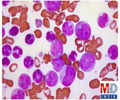HTLV-1, the human virus that causes a rare form of leukaemia was found to increase disease risk by changing the way DNA loops inside the cells.

‘HTLV-1, the human virus that causes a rare form of leukaemia was found to increase disease risk by changing the way DNA loops inside the cells.’





HTLV-1 is thought to infect more than 10 million people around the world. The virus can be transmitted through unprotected sex, blood transfusions, and from mother to baby via breast milk. People can carry the virus for decades without symptoms, and 90 per cent of people may be unaware they are carrying it at all. However, an estimated 5-10 per cent of those infected may go on to develop an aggressive form of leukaemia or a progressive paralytic disease.
In the latest study, researchers looked at how HTLV-1 interacts with human DNA when it infects a host, focusing on its target: specialised white blood cells called T-cells.
Each human cell contains around two metres of DNA, neatly packaged into the nucleus. In order to fit, these twisting strands are tightly coiled and then wrapped around proteins, creating a densely packed genetic spaghetti structure called chromatin.
The chromatin is not randomly organised, but is folded into thousands of loops, which stick out from the main 'strand'. These loops expose certain regions of DNA to the cell's machinery that reads and copies DNA, enabling specific chunks of the genome to be more easily read and transcribed.
Advertisement
The research team isolated T-cells from HTLV-1-infected patients and analysed which regions of the DNA were altered. They found that the virus binds to a protein called CTCF, which is the key protein that forms normal loops in the human genome. As a result, the virus changes the structure of the loop and the activity of genes within it.
Advertisement
The researchers explain that due to the large number of CTCF sites scattered throughout the human genome, viruses such as HTLV-1 have the potential to disrupt tens of thousands of genes in the human genome.
They add that the findings provide new insight into how viruses like HTLV-1 can alter the structure of the human genome, which can result in diseases such as cancer.
Ewan Birney, Director of the European Bioinformatics Institute (EMBL-EBI) and co-author, added: "This study illustrates that by combining wet lab and dry lab expertise, we can explore previously inaccessible biological processes.
"By integrating complex genomic data - in this case haplotype-resolved data - into our analysis, we have gained new insights into how the human T-cell leukaemia virus works. In turn, this could help us understand why certain patients experience such devastating symptoms, while others are asymptomatic."
Source-Eurekalert












